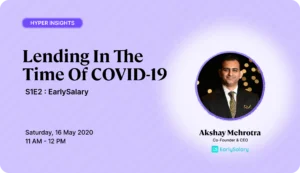Akshay Mehrotra, Co-founder and CEO EarlySalary, sheds light on the future of fintech in India, from demand to collections. As a bonus, he shares a few interesting observations including one about the speed of typing one’s address.
Introduction
EarlySalary has created a category that has touched millions of white-collar and blue-collar workers and continues to do so through these times. Kedar, our CEO, spoke to Akshay Mehrotra on the future of fintech on 16th May at 11 am in the second episode of HyperInsights Season 1: Lending in the Time of COVID.
The Future of Fintech (link)
The Context
When the world came to a halt in early March, so did economic activity, and all the systems that power it. As a result, the business of lending and borrowing felt the impact from all fronts. Banks, NBFCs, and many new-age fintech startups suddenly found themselves with a customer base that could not borrow. And since discretionary spending had come down, perhaps customers didn’t have the need to either. Akshay draws on his experience to show us that although the initial data seems to point at an existential crisis, it isn’t so. And that, earlier crises could have been scaffoldings for today.
HyperInsights
Looking back in the recent past
In retrospect, recent bumps in the last 18 months have been blessings in disguise, how?
- The two NBFC crises helped us understand how to put in place effective frameworks and pitfalls to avoid
- The banking crisis helped highlight the importance of digital systems that can adapt to changes real-time
- Fintechs have been driven to accept that it’s more prudent to adopt a hybrid approach (i.e. neither overly asset-heavy too asset-light)
Predictions for the near future
- Lending is now such that every transaction with a customer may be an opportunity for lending – e-commerce, point of sale, UPI transaction, etc.
- Every traditional lender will aim for an end-end digital operation. And they will tailor their offerings to be more
(a) Specific to a particular need
(b) Sachet-size, shorter-term - A rejig of fintech business models
(a) Business models relying on unsustainable high-interest lending will find it difficult to survive when the dust settles
(b) Fintechs focusing on core functions such as process automation, alternative credit modelling, and others will prosper - Alternative scoring will be more important than ever before.
Debunking the “commoditization” of fintech
- Even though it’s likely that ~10,000 existing NBFCs will offer fintech-like experiences in the near future, the financial services industry in India has a lot of room to grow.
- The system is built to avoid being skewed towards single-player dominance. The largest player in the financial services industry occupies about 2% of total market share.
Tackling Fraud (link)
The Context

Lenders will have to become smarter, and that’s not just lip-service. Tackling fraud before it becomes a part of the system will be crucial to maintaining AUM (Assets Under Management) health. In-person collections are now harder and will have to be supported/replaced with other systems.
HyperInsights
Detecting fraud before it happens
- Akshay mentioned that the main types of fraud are salary proof fudging, KYC, and impersonation. EarlySalary has been able to build systems that can flag fraudulent behavior. Examples:
(a) Internal indicator: how the forms are filled on the ES app
(b) External indicator: Tampering in PDF bank statements - Interesting data point: Data prior to COVID suggested that 2/3rd of personal loans are already originated online.
Note: HyperVerge tackles KYC and impersonation fraud with AI
Collections with a conscience
Akshay’s key insights into running sustainable and customer friendly collections:
- Making the mode of collections easy
(a) Mapping the right bank account
(b) Prioritising setting up of eNACH and Digital Standing Instruction (SI) based collection
(c) Automating collection messages that are contextual - Recalibrating how on-ground agents operate
(a) Training call centre and agents to be polite and cordial
(b) Escalating to in-person collections only under extreme circumstances and collating collection visits to clusters
Note: Spike in FTD (First Time Defaults) is a key indicator to the health of a lender’s portfolio. If COVID has caused a 4-5x (or more) increase then, it’s not a good sign.
Questions and recurrent theme
The interaction with the audience revealed some interesting insights. Some of them are summarised here, and the rest are in the video.
Questions
- On will the market of unsecured/secured loans change (link)
- On alternate sources of data and the comparison between traditional alternate scoring systems (link)
- On interesting non-private consumer data (link)
- On collections (link)
- On why so many NBFCs and MFIs are not digital and if it is a good time for fintechs to move into this and into unsecured loans (link)
- On lending rates as pre and post COVID-19 (link)
- On the evolution of NACH post-COVID (link)
- On the rise of digital banks (link)
- On the qualities, a lender should have to emerge from this crisis (link)
- On maintaining composure during these times (link)
Recurrent theme
On the subject of credit scores, Akshay noted that traditional bureau score will no longer be a proxy for future consumer behaviour. Current alternative scoring models might also fail because they rest on peace-time data. Lenders will need to develop alternative scoring models which are re-calibrated with non-traditional inputs such as
- App usage behaviour such as finger movement patterns
- Geo-location based insights
However, bureau data on loan repayments in the last few months will be very valuable. On the subject of demand, Akshay mentioned that demand for unsecured loans will be low to non-existent for a while before picking up. This would be because discretionary spending has come down.
And on that note, we stop here, and urge you to watch the entire video. This interview with Akshay happened right after Priya Sharma of ZestMoney and before Karan Mehta of Kissht, both of whom offered nuanced perspectives of the financial and technical side of lending in the time of COVID-19.





